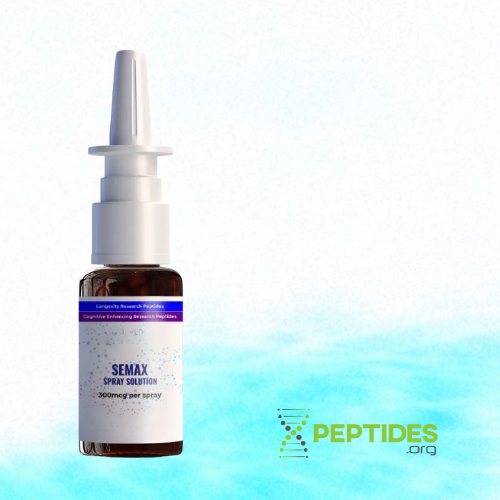Buy Semax Online | 99% Purity | USA-Made

Semax is a synthetically modified analog of ACTH (4-10) that demonstrates nootropic and neuroprotective activity. It was originally formulated and studied in Russia for its benefits on brain health and cognitive function, and is still under active study for these benefits and as a therapeutic tool in neurological diseases.
Availability: In-Stock
Price: $76.99
- FREE Shipping for orders over $200 (USA Only)
- $9.25 Flat Rate Shipping, USA Orders
- Includes one 30mL Bacteriostatic Water with orders over $200

What is Semax?
Semax, or ACTH (4-7) Pro-Gly-Pro, is a research peptide offering various potential neuroprotective and cognitive benefits.
It is a heptapeptide made of 4 amino acids (Met-Glu-His-Phe) at the N-terminus taken from ACTH(4-7) and a Pro-Gly-Pro fragment at the C-terminus [1].
This unique chemical structure was engineered to let Semax directly cross the blood-brain barrier (BBB) and exert its therapeutic effects [2, 3].
Semax was first developed in the former Soviet Union in the late 1980s. The research peptide is believed to offer potential therapeutic benefits for individuals suffering from dementia, stroke, general cognitive decline, and other cognitive diseases [4].
The latest studies show that Semax likely works by activating dopaminergic and serotonergic brain systems, increasing levels of Brain-Derived Neurotrophic Factor (BDNF) and Nerve Growth Factor (NGF), and protecting neurons against oxidative stress [5, 6, 7, 8, 9].
In addition to its regular form, Semax is also available as an acetylated and amidated formulation, known as N-Acetyl Semax Amidate. These modifications are thought to improve the peptide’s stability and potency [10].
Before buying Semax or N-Acetyl Semax Amidate for research purposes, it's important to consider this peptide's benefits, side effects, contraindications, and legal status.
Our team of experts addresses all of these considerations below before revealing our top recommendations for where researchers can buy Semax online.

Benefits of Semax
Semax is a sought-after peptide for researchers studying rehabilitation protocols for test subjects suffering from various neurological disorders.
Here are a few of the potential benefits of this peptide:
- Cognitive enhancement
- Mood regulation
- Neuroprotective properties
Let's take a closer look at each of these benefit categories.
Semax for Cognitive Enhancement
The available pre-clinical and clinical data show that Semax has the following potential benefits for overall brain health and cognitive performance [4, 11, 12, 13]:
- Enhanced memory and recall: Research shows that Semax can boost memory and recall thanks to its potential nootropic effects in the brain [11].
- Sharper focus and sustained attention: Preliminary research suggests that Semax may benefit attention and memory [4, 12].
- Boosted information processing: Thanks to its ability to increase the volume of the rostral subcomponent of the brain's default mode network (DMN), Semax may offer benefits for information processing and episodic memory [13].
Semax for Mood Regulation
Semax is suggested to provide benefits for mood regulation, including anxiolytic and antidepressant effects in laboratory animal experiments [14, 15].
Here are the most notable findings in regard to Semax’s mood regulation potential:
- Alleviation of anxiety symptoms: Preclinical studies show that Semax may modulate the stress response of rats exposed to anxiogenic substances, thus alleviating some of their anxiety-related symptoms [14].
- Antidepressant-like effects: Long-term administration of the peptide in rats reveals that it may provide both anxiolytic and antidepressant effects [15].
Semax for Neuroprotection
Due to its unique chemical structure and mechanism of action, Semax appears to offer neuroprotective properties in a variety of neurological conditions, including:
- Acute ischemia (stroke patients) [16]
- Chronic ischemia (vascular dementia) [17]
- Murine models of Parkinson's [18]
- Laboratory models of Alzheimer's dementia [19]
- Optic nerve damage in glaucoma patients [20]
- Protection against neurotoxins such as alcohol [21]
According to these clinical and pre-clinical studies, Semax protects the brain from further damage by increasing tolerance to hypoxia, reducing inflammation, and upregulating growth factors that may benefit nerve cell regeneration and neuroplasticity.
Other Potential Benefits of Semax
Semax potentially offers benefits unrelated to improvements in neurological function, such as an apparent gastroprotective effect [22].
One study in patients with refractory peptic ulcers reported anti-ulcer effects following application of intranasal 1% Semax at a dose of 2-4 drops three times a day for ten days. The peptide was well-tolerated and led to ulcer healing in 89.5% of patients receiving the peptide vs. 30.8% in the control group [22].
More quality studies are needed to explore the potential benefits of Semax outside its application as a nootropic and/or neuroprotective agent.
Semax Safety and Side Effects
Semax has been studied since the late 1980s with noteworthy results for a variety of neurological conditions. It is currently approved for use in Russia and Ukraine as a safe neuroprotective and cognitive-enhancing agent in ischemic brain stroke, encephalopathy, optic nerve atrophy, and other neurological indications [23].
Published clinical research also confirms the peptide’s safety and does not report any specific side effects related to Semax in doses ranging from 600mcg-12000mcg when applied intranasally [4, 16, 17, 20, 21, 24].
One of the longest studies to date involved 30 days of intranasal application as a 0.1% solution in 36 glaucoma patients and also did not report any side effects [25].
Kaplan et al. (1996) noted that a single dose of 16mcg/kg of body weight may induce some anxiogenic effects on test subjects related to its nootropic and stimulating benefits. However, other researchers have not confirmed these concerns [11].
In contrast, clinical research is scarce regarding the administration of injectable Semax. Nevertheless, the peptide has not demonstrated any adverse effects following its administration via injection in laboratory animal models.
Qualified professionals planning to include the injectable Semax in their trials should note that safety data still remains scarce.
To minimize potential risks, researchers may consider adhering to the following safety tips when administering Semax in experimental settings:
- Start with a low dose: A conservative dose of 500-1000 mcg/daily (for Semax injections) may be appropriate for most research subjects. Semax is best cycled for up to 30 days, followed by a rest period that is equivalent to the initial course’s duration.
- Monitor the response: Closely monitor each test subject's overall response to Semax, especially for the first few days of the study, to ensure the Semax is well-tolerated and there are no unexpected side effects.
- Stay hydrated: Anecdotal reports suggest that Semax may be associated with headaches, which can be minimized by drinking sufficient water throughout the day.
- Limit use of other nootropics: Other nootropics, including dietary supplements like Alpha-GPC and Lion's Mane, may sometimes be used alongside Semax. However, if side effects such as increased anxiety are a concern, nootropic stacking should be minimized.
- Limit caffeine intake: Caffeine use may also increase the risk of side effects while taking Semax. Encourage all Semax research participants to reduce or eliminate caffeine intake to reduce the risk of side effects.
By following these steps, in addition to selecting a reliable peptide vendor and establishing a judicious dosing protocol, researchers will maximize the odds of success.

Where to Buy Semax Online? | 2024 Version
Semax is readily accessible for online purchase by peptide researchers and laboratory professionals.
As an increasing number of vendors now offer Semax and various other research peptides for sale, it is crucial for researchers to thoroughly evaluate their options before proceeding with a purchase.
To mitigate the risk of obtaining peptides of subpar purity, we strongly advise purchasing exclusively from vendors who source their peptides from accredited facilities and subject all compounds to third-party purity verification.
Here are our top recommendations for both Semax nasal spray and Semax powder for injection.
Limitless Life
We endorse Limitless Life as a reputable source of Semax nasal spray. The vendor excels across the board for the following reasons:
- Third-Party Tested Peptides: Limitless Life prioritizes the quality and purity of their peptides, subjecting them to meticulous third-party laboratory testing. They provide a comprehensive Certificate of Analysis for complete peace of mind.
- Outstanding Service: Limitless Life stands by their commitment to satisfaction and are quick to resolve any errors or mistakes in the shipping process.
- Convenient Payment Options: To enhance convenience, the vendor offers various payment methods, including credit cards, Cash App, and e-check.
Limitless Life also offers N-Acetyl Semax Amidate nasal spray for researchers interested in procuring the modified version.
Buy Semax Nasal Spray from our top-rated vendor...

PureRawz
PureRawz has been long recognized as a reliable provider of research-grade nootropics and other peptides, presenting numerous benefits, such as:
- Rigorous Quality Testing: PureRawz compounds are thoroughly tested both in-house and by a third-party laboratory to ensure suitability for research.
- Comprehensive Selection: This vendor has among the most extensive product selections available on the web, including nootropic, weight loss, and injury recovery peptides.
- Impressive Support: The PureRawz team is always happy to assist researchers and are accessible by phone, live chat, or email.
Buy research peptides from Pure Rawz today...

Semax Forms of Administration
Researchers may be wondering how to administer Semax. There are two main methods to administer the peptide as a reference material in research settings:
- Nasal Spray
- Subcutaneous Injections
Below, researchers can take a closer look at each option.
Semax Nasal Spray
Semax was originally designed for intranasal administration. Indeed, this administration method has notable advantages: it is easy to administer, painless, and will not cause injection-related side effects.
Here are the steps for administering Semax nasal spray:
- Disinfect the application nozzle with an alcohol swab, and gently roll the solution to ensure it is properly mixed. Do not shake.
- Instruct the test subject to blow their nose to remove congestions and determine which nostril is more open.
- Tilt the subject's head, gently close one nostril using the non-dominant hand, and grasp the nasal spray in the dominant hand.
- Insert the nozzle into the open nostril as far as possible. Press down on the spray bottle to release a single spray. Instruct subjects to inhale through their nose slowly and gently.
- Wait 30-60 seconds in between sprays, and repeat for the desired number of doses (if necessary).
- After administering the dose, disinfect the nozzle with an alcohol swab and refrigerate the bottle.
For more information, make sure to check out our dedicated article on Semax nasal spray handling and storage.
Semax Injections
Subcutaneous injections are another viable administration route of Semax for research purposes.
It's important to note that injectable Semax for research is usually available as a lyophilized powder that must be reconstituted before use with a sterile solvent such as bacteriostatic water.
Once reconstituted, here are the main steps that researchers must follow when administering the research peptide:
- Gather all necessary items: vial of reconstituted Semax peptide, sterile needles and syringes, alcohol swabs, and a sharps container.
- Disinfect the vial's stopper and draw the desired dosage into a sterile syringe. Avoid shaking or tapping the syringe to prevent damage to the peptide.
- Disinfect the subject's skin at the injection site. Pinch the skin gently with the non-dominant hand, considering variations in subcutaneous fat thickness. Subcutaneous injections can be given in the abdomen, thigh, or upper arm.
- Insert the needle at a 45-degree angle, bevel up. Slowly depress the plunger to administer the Semax solution.
- Wait a few seconds after injecting and then withdraw the syringe. Dispose of used needles and syringes in the sharps container.
- Apply light pressure to the injection site using an alcohol swab.
Ensure proper hygiene, follow sterile procedures, and rotate injection sites for safety and effectiveness when administering subcutaneous injections of Semax.
Semax Nasal Spray vs. Injections
When considering the choice between purchasing Semax nasal spray or injections for research purposes, professionals need to account for various factors to determine the better option. These factors include the research objective, subject compliance, and cost-effectiveness.
Leading researchers have successfully utilized both options in their studies, so it is essential to understand the pros and cons of each before making a final decision on the route of administration.
Effectiveness of Semax Nasal Spray vs. Injections
In terms of effectiveness, the subcutaneous route of administration offers advantages such as precise and reliable dosing, with fewer factors that may interfere with absorption and bioavailability.
Therefore, Semax injections are preferred for researchers looking to ensure consistent absorption and bioavailability among test subjects [26].
On the other hand, laboratory animal studies comparing intranasal vs. injectable Semax report that the nasal route of administration may be more potent for improving learning capabilities [27].
Administering Semax Nasal Spray vs. Injections
Regarding the form of administration, Semax nasal spray offers advantages in terms of ease. It is easy to administer and tolerable for most test subjects.
By contrast, some test subjects may find Semax injections painful, unpleasant, or poorly tolerated due to reactions at the injection site, leading to reduced compliance. If ease of administration is crucial, researchers are encouraged to use Semax nasal spray in their studies.
Safety of Semax Nasal Spray vs. Injections
Considering side effects, intranasal Semax has been more extensively researched and shown generally well-tolerated. Injectable Semax has been applied primarily in laboratory animal studies [18, 25, 27].
Notably, Semax administration via subcutaneous injections carries a risk of specific side effects such as pain, skin irritation, redness, bleeding, swelling, and infections. More research is necessary to evaluate the safety of Semax injections compared to intranasal Semax.
Cost of Semax Nasal Spray vs. Injections
Cost and accessibility are additional factors to consider. The cost of Semax injectable and nasal spray products can vary depending on the source. For example, Semax nasal spray is available as a 30mg spray bottle from Limitless Life Nootropics for $76.99.
A 30mg/10ml Semax nasal spray delivers 300mcg per pump. Thus, one 30mg spray bottle will be sufficient for 50 days if administered at two pumps/daily, 33 days at three pumps/daily, and 25 days at four pumps/daily.
On the other hand, aliquot Semax in the form of a 30mg vial from this research peptides vendor cost $76.48.
While both forms are available at an affordable price from reliable online vendors, Semax injections are priced lower when accounting for the subcutaneous route’s superior bioavailability.
Semax for Sale | Verdict
Semax was first developed in the 1980s and today remains one of the more promising research peptides for cognitive enhancement and neuroprotection.
Researchers must be fully aware of the peptide’s mechanisms, potential side effects, and dosing recommendations before embarking on a Semax experiment.
There are a number of online peptide vendors offering Semax for sale, available in either nasal spray or injectable format.
Limitless Life Nootropics stocks research-grade Semax nasal spray.
References
- Dmitrieva, V. G., Povarova, O. V., Skvortsova, V. I., Limborska, S. A., Myasoedov, N. F., & Dergunova, L. V. (2010). Semax and Pro-Gly-Pro activate the transcription of neurotrophins and their receptor genes after cerebral ischemia. Cellular and molecular neurobiology, 30(1), 71–79. https://doi.org/10.1007/s10571-009-9432-0
- Khavinson, V., Ilina, A., Kraskovskaya, N., Linkova, N., Kolchina, N., Mironova, E., Erofeev, A., & Petukhov, M. (2021). Neuroprotective Effects of Tripeptides-Epigenetic Regulators in Mouse Model of Alzheimer's Disease. Pharmaceuticals (Basel, Switzerland), 14(6), 515. https://doi.org/10.3390/ph14060515
- Shevchenko, K. V., Nagaev, I. I.u, Alfeeva, L. I.u, Andreeva, L. A., Kamenskiĭ, A. A., Levitskaia, N. G., Shevchenko, V. P., Grivennikov, I. A., & Miasoedov, N. F. (2006). Bioorganicheskaia khimiia, 32(1), 64–70. https://doi.org/10.1134/s1068162006010055
- Asmarin, I. P., Nezavibat'ko, V. N., Miasoedov, N. F., Kamenskiĭ, A. A., Grivennikov, I. A., Ponomareva-Stepnaia, M. A., Andreeva, L. A., Kaplan, A. I.a, Koshelev, V. B., & Riasina, T. V. (1997). Nootropnyĭ analog adrenokortikotropina 4-10-semaks (15-letniĭ opyt razrabotki i izucheniia) [A nootropic adrenocorticotropin analog 4-10-semax (l5 years experience in its design and study)]. Zhurnal vysshei nervnoi deiatelnosti imeni I P Pavlova, 47(2), 420–430.
- Sciacca, M. F. M., Naletova, I., Giuffrida, M. L., & Attanasio, F. (2022). Semax, a Synthetic Regulatory Peptide, Affects Copper-Induced Abeta Aggregation and Amyloid Formation in Artificial Membrane Models. ACS chemical neuroscience, 13(4), 486–496. https://doi.org/10.1021/acschemneuro.1c00707
- Medvedeva, E. V., Dmitrieva, V. G., Povarova, O. V., Limborska, S. A., Skvortsova, V. I., Myasoedov, N. F., & Dergunova, L. V. (2014). The peptide semax affects the expression of genes related to the immune and vascular systems in rat brain focal ischemia: genome-wide transcriptional analysis. BMC genomics, 15, 228. https://doi.org/10.1186/1471-2164-15-228
- Shadrina, M., Kolomin, T., Agapova, T., Agniullin, Y., Shram, S., Slominsky, P., Lymborska, S., & Myasoedov, N. (2010). Comparison of the temporary dynamics of NGF and BDNF gene expression in rat hippocampus, frontal cortex, and retina under Semax action. Journal of molecular neuroscience : MN, 41(1), 30–35. https://doi.org/10.1007/s12031-009-9270-z
- Filippenkov, I. B., Stavchansky, V. V., Denisova, A. E., Yuzhakov, V. V., Sevan'kaeva, L. E.,Sudarkina, O. Y., Dmitrieva, V. G., Gubsky, L. V., Myasoedov, N. F., Limborska, S. A., & Dergunova, L. V. (2020). Novel Insights into the Protective Properties of ACTH(4-7)PGP (Semax) Peptide at the Transcriptome Level Following Cerebral Ischaemia-Reperfusion in Rats. Genes, 11(6), 681. https://doi.org/10.3390/genes11060681
- Sudarkina, O. Y., Filippenkov, I. B., Stavchansky, V. V., Denisova, A. E., Yuzhakov, V. V., Sevan'kaeva, L. E., Valieva, L. V., Remizova, J. A., Dmitrieva, V. G., Gubsky, L. V., Myasoedov, N. F., Limborska, S. A., & Dergunova, L. V. (2021). Brain Protein Expression Profile Confirms the Protective Effect of the ACTH(4-7)PGP Peptide (Semax) in a Rat Model of Cerebral Ischemia-Reperfusion. International journal of molecular sciences, 22(12), 6179. https://doi.org/10.3390/ijms22126179
- Shevchenko, K. V., Nagaev, I. Y., Andreeva, L. A., Shevchenko, V. P., & Myasoedov, N. F. (2019). Prospects for Intranasal Delivery of Neuropeptides to the Brain. Pharmaceutical Chemistry Journal, 53, 89-100.
- Kaplan, A. Y. A., Kochetova, A. G., Nezavibathko, V. N., Rjasina, T. V., & Ashmarin, I. P. (1996). Synthetic acth analogue semax displays nootropic‐like activity in humans. Neuroscience Research Communications, 19(2), 115-123.
- Agapova, T. I.u, Agniullin, I.aV., Silachev, D. N., Shadrina, M. I., Slominskiĭ, P. A., Shram, S. I., Limborskaia, S. A., & Miasoedov, N. F. (2008). Molekuliarnaia genetika, mikrobiologiia i virusologiia, (3), 28–32.
- Lebedeva, I. S., Panikratova, Y. R., Sokolov, O. Y., Kupriyanov, D. A., Rumshiskaya, A. D., Kost, N. V., & Myasoedov, N. F. (2018). Effects of Semax on the Default Mode Network of the Brain. Bulletin of experimental biology and medicine, 165(5), 653–656. https://doi.org/10.1007/s10517-018-4234-3
- Levitskaia, N. G., Vilenskiĭ, D. A., Sebentsova, E. A., Anreeva, L. A., Kamenskiĭ, A. A., & Miasoedov, N. F. (2010). Izvestiia Akademii nauk. Seriia biologicheskaia, (2), 231–237.
- Vilenskiĭ, D. A., Levitskaia, N. G., Andreeva, L. A., Alfeeva, L. I.u, Kamenskiĭ, A. A., & Miasoedov, N. F. (2007). Rossiiskii fiziologicheskii zhurnal imeni I.M. Sechenova, 93(6), 661–669.
- Gusev, E. I., Martynov, M. Y., Kostenko, E. V., Petrova, L. V., & Bobyreva, S. N. (2018). Éffektivnost' semaksa pri lechenii bol'nykh na raznykh stadiiakh ishemicheskogo insul'ta [The efficacy of semax in the tretament of patients at different stages of ischemic stroke]. Zhurnal nevrologii i psikhiatrii imeni S.S. Korsakova, 118(3. Vyp. 2), 61–68. https://doi.org/10.17116/jnevro20181183261-68
- Cherkasova, K. (2003). P. 6.013 Step forward in research of chronic ischemic brain disease during Semax therapy. European Neuropsychopharmacology, (13), S432.
- Levitskaya, N. G., Sebentsova, E. A., Andreeva, L. A., Alfeeva, L. Y., Kamenskii, A. A., & Myasoedov, N. F. (2004). The neuroprotective effects of Semax in conditions of MPTP-induced lesions of the brain dopaminergic system. Neuroscience and behavioral physiology, 34(4), 399–405. https://doi.org/10.1023/b:neab.0000018752.59465.28
- Sciacca, M. F. M., Naletova, I., Giuffrida, M. L., & Attanasio, F. (2022). Semax, a Synthetic Regulatory Peptide, Affects Copper-Induced Abeta Aggregation and Amyloid Formation in Artificial Membrane Models. ACS chemical neuroscience, 13(4), 486–496. https://doi.org/10.1021/acschemneuro.1c00707
- Kurysheva, N. I., Shpak, A. A., Ioĭleva, E. E., Galanter, L. I., Nagornova, N. D., Shubina, N. I.u, & Shlyshalova, N. N. (2001). "Semaks" v lechenii glaukomatoznoĭ opticheskoĭ neĭropatii u bol'nykh s normalizovannym oftal'motonusom [Semax in the treatment of glaucomatous optic neuropathy in patients with normalized ophthalmic tone]. Vestnik oftalmologii, 117(4), 5–8.
- Strelets, N. V., & Utkin, S. Y. (2005). P. 6.020 Use of the neurometabolic drug "Semax" for complex treatment of alcohol delirium. European Neuropsychopharmacology, (15), S275.
- Ivanikov, I. O., Brekhova, M. E., Samonina, G. E., Myasoedov, N. F., & Ashmarin, I. P. (2002). Therapy of peptic ulcer with semax peptide. Bulletin of experimental biology and medicine, 134(1), 73–74. https://doi.org/10.1023/a:1020621124776
- Kolomin, T., Shadrina, M., Slominsky, P., Limborska, S., & Myasoedov, N. (2013). A new generation of drugs: synthetic peptides based on natural regulatory peptides. Neuroscience & Medicine, 4(04), 223.
- Serdiuk, A. V., Levitskiĭ, G. N., Miasoedov, N. F., & Skvortsova, V. I. (2007). Zhurnal nevrologii i psikhiatrii imeni S.S. Korsakova, 107(4), 29–39.
- Strakhov, V. V., Popova, A. A., & Fedorov, V. N. (2014). The results of Semax neuroprotective efficacy investigation. Ophthalmology Reports, 7(4), 43-51.
- Meredith, M. E., Salameh, T. S., & Banks, W. A. (2015). Intranasal Delivery of Proteins and Peptides in the Treatment of Neurodegenerative Diseases. The AAPS journal, 17(4), 780–787. https://doi.org/10.1208/s12248-015-9719-7
- Manchenko, D. M., Glazova, N. I.u, Levitskaia, N. G., Andreeva, L. A., Kamenskiĭ, A. A., & Miasoedov, N. F. (2010). Rossiiskii fiziologicheskii zhurnal imeni I.M. Sechenova, 96(10), 1014–1023.
There are no reviews yet. Be the first one to write one.
